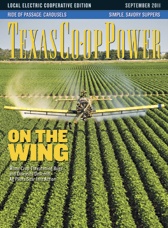There never was a Texas town quite like Thurber, and there probably never will be again. In a state not known for coal, Thurber produced tons of “black diamonds” from the late 1880s to the 1920s. In a state known for its independence, Thurber was a wholly company-owned town, right down to the last nail in the last miner’s house. And in a state with a scant labor union presence, Thurber became a union town largely populated by foreign-born workers.
Thurber, one of the state’s most-celebrated ghost towns, sits in the northwest corner of Erath County, southwest of Fort Worth. This was not a land of cotton or cattle but of coal, bricks and, later, oil. By the turn of the 20th century, Thurber was at the heart of the leading coal-producing area in the state, and Texas’ coal output exceeded the value of all other minerals combined.
It all started when a land speculator from Michigan, William Whipple Johnson, discovered coal in the area in the 1880s and began mining operations. When the miners went on strike, Johnson sold the company to a group of Eastern investors who formed the Thurber-based Texas and Pacific (T&P) Coal Company. A contract with the Texas and Pacific Railway, originally negotiated by Johnson, was renegotiated, and a new town named for T&P Coal Company investor H.K. Thurber was built.
Thurber wasn’t just a new town—it was a new kind of town and one of the first in the state to have full electric service, in 1895. The ice factory, with a 17-ton capacity, was considered the largest in the Southwest. There was even an opera house. In A Personal Country, a memoir about vast West Texas, author A.C. Greene wrote that Thurber had “a kind of dangerous pretension.”
Greene wrote, “Thurber was a mining town, an industrial city, and a true city, while most of the rest of West Texas burned cow chips for fuel and gathered buffalo bones to sell to survive the droughts. While other towns in West Texas considered the buckboard and the buggy the ultimate in transportation, Thurber had a siding, a special parking area, for the Pullman Palace cars and private sleepers which were set off the mainline Texas and Pacific Railway at Mingus for the short ramble down to Thurber’s station on the town square.”
Thurber was a company town, and only company miners, along with some schoolteachers and preachers, were allowed to live there. That made for a diverse population with representation from some 18 ethnic groups. Italians made up more than half of the workforce with Polish immigrants representing about 12 percent. A mine workers’ union was formed in 1903. A second union, the Italian Local, followed in 1906. Thurber became known as the only 100 percent closed-shop (all-union) city in the country.
The surrounding land contained a lot of shale clay, which the glad hands of Thurber industry turned into bricks. “All its streets and sidewalks, its smokestack and pumphouse, the bandstand on the square, railroad abutments, bridges, and watering troughs—all were made of brick,” Greene wrote of the town.
In the course of looking for coal and other mineral deposits, mine manager William Knox Gordon hit oil a few miles from Thurber, near Strawn. That led to the discovery of the wildly productive Ranger oil field in October 1917 and the beginning of an oil boom that changed everything, including Thurber.
Thurber initially prospered from the local oil boom. The T&P Coal Company added “and Oil” to its name, but when locomotives converted from coal-fired steam engines to oil burners, Thurber had no market for its coal. To make up for the loss of the coal market, Thurber began producing paving bricks, which paved many Texas highways and streets, including Congress Avenue in downtown Austin. They were also used to construct the Galveston seawall and the Fort Worth Stockyards. Then along came concrete and asphalt roads, and the market for the paving bricks went the way of coal-fired steam engines.
One morning in 1933, the T&P Coal Company announced that the town was being abandoned. The utility poles were taken down, the wire salvaged. Houses were boarded shut, and supplies in company stores were sold at cost. In a blink, the Texas city that was like no other joined so many others that flourished for a time and then vanished.
“Thurber had been built all at once, its population had come all at once, and everything it did, it did all at once,” Greene wrote. “And as things turned out, it died all at once.”
——————–
Clay Coppedge is a regular contributor to Texas Co-op Power.


